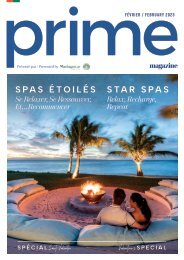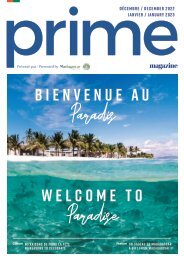Prime-Magazine-July-2023
You also want an ePaper? Increase the reach of your titles
YUMPU automatically turns print PDFs into web optimized ePapers that Google loves.
DESTINATIONS<br />
NOSY LONJO<br />
Symbole de la ville d’Antsiranana, Nosy Lonjo ou «Pain de<br />
sucre» est un îlot situé au cœur de la baie. Un magnifique<br />
décor et un lieu sacré et un lieu de culte, on l’appelle<br />
également «Nosy Ravo Hely». L’appellation «Pain de sucre»<br />
vient de sa forme conique qui rappelle les moules utilisés au<br />
XIXe siècle pour vendre et conserver le sucre. Des théories<br />
avancent que l’îlot est d’origine volcanique et d’autres<br />
hypothèses soutiennent qu’il serait un détachement de la<br />
Montagne des Français. Vers la partie est de la ville, Nosy<br />
Lonjo (122m d’altitude pour 4,5ha de superficie) prend la<br />
forme d'une bosse de zébu, ressemblant à un écrin posé au<br />
milieu de la mer.<br />
Le roi Lonjo be y est enterré et ses descendants organisent<br />
régulièrement des rituels. Bien que l’accès pour prier soit<br />
réservé aux descendants directs de la lignée royale, des<br />
croyants peuvent également demander des faveurs.<br />
MONTAGNE D’AMBRE<br />
Cette aire protégée englobe à la fois un parc<br />
national terrestre et une réserve spéciale. Mis en<br />
place en 1958, il s’agit du premier parc national<br />
de Madagascar situé à 38km d’Antsiranana et<br />
à trois kilomètres de Joffreville. La montagne<br />
d’Ambre est un massif volcanique culminant à<br />
1475m, on doit son nom aux résines ambrées<br />
qui coulaient le long de ses arbres. Avec le<br />
climat subhumide du nord de l’île, ce parc est<br />
riche en plantes endémiques à l’instar des<br />
Barleria vincaefolia, Dioscorea sambiranensis,<br />
Psychotria bealananensis. On compte 31<br />
espèces endémiques de la montagne d’Ambre<br />
mais également des milliers d’espèces de<br />
bois précieux le Dalbergia chlorocarpa et le<br />
Canarium madagascariensis. Côté faune, le site<br />
abrite des espèces de reptile, d’amphibiens, de<br />
lémuriens, de tenrecidés et d’oiseaux. Ce parc<br />
regroupe également des lacs et des cascades<br />
dont la cascade touristique, la cascade<br />
sacrée, la cascade Antakarana et la cascade<br />
d’Antomboka, cette dernière chute d’une<br />
hauteur de 80m.<br />
Des théories avancent que<br />
l’îlot est d’origine volcanique<br />
© : ONTM<br />
One theory is that the island<br />
is of volcanic origin<br />
A symbol of the town of Antsiranana, Nosy Lonjo or ‘Sugarloaf’<br />
is a small island lying at the heart of the bay. A beautiful spot, a<br />
sacred site and a place of worship, it is also referred to as ‘Nosy<br />
Ravo Hely’. Its name of ‘Sugarloaf’ comes from its conical shape,<br />
recalling the moulds used in the 19th century to sell and conserve<br />
sugar. One theory is that the island is of volcanic origin, while<br />
other hypotheses indicate that it became detached from the<br />
Montagne des Français. Located towards the east of the town, Nosy<br />
Lonjo (122m in altitude and covering an area of 4.5ha) has the<br />
shape of a zebu’s hump, a sort of treasure chest rising up from the<br />
middle of the sea.<br />
The King Lonjo is buried here and his descendants regularly<br />
organise rituals. Only direct descendants of the royal line can take<br />
part in the prayers, but other worshippers can also request favours.<br />
AMBER MOUNTAIN<br />
This protected area covers both the national park<br />
on land and the special reserve. Set up in 1958,<br />
it was Madagascar’s first national park, situated<br />
38km from Antsiranana and 3km from Joffreville.<br />
The Amber Mountain is a range of volcanic peaks<br />
culminating at 1,475m. It owes its name to the<br />
amber resin flowing out of the trees that grow<br />
here. With the sub-humid climate in the north of<br />
the island, the park is rich in endemic flora such<br />
as Barleria vincaefolia, Dioscorea sambiranensis<br />
and Psychotria bealananensis. There are 31<br />
endemic species growing on the Amber Mountain,<br />
but also thousands of species of precious woods,<br />
such as Dalbergia chlorocarpa and Canarium<br />
madagascariensis. As regards the fauna, the site<br />
shelters several species of reptiles, amphibians,<br />
lemurs, tenrecs and birds. The park also has lakes<br />
and waterfalls, including one that is popular with<br />
tourists, the sacred waterfall, Antakarana and the<br />
waterfall of Antomboka, with a drop of 80m.<br />
online at www.primemedia.international / 105
















